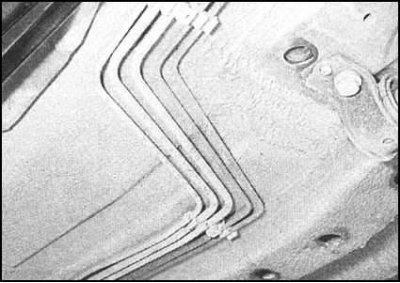2. In parallel, check the condition and reliability of fastening on their fittings of all hoses and metal tubes related to the operation of the engine. Follow the reliability of fastening the lines with cable bandages, clamps and intermediate clamps. Replace broken clips with new ones to avoid chafing lines.
3. Carefully inspect the radiator hoses and interior heating hoses along their entire length. Replace the defective hose if cracks, blisters, or signs of aging of the material are found.
Note. Cracks are easier to identify by bending the hose. Carefully check up a condition of collars of fastening of hoses on connecting branch pipes of components of the cooling system. Do not forget that often the hoses are frayed and worn out precisely at the places where the clamps are installed. It would be most correct to replace the failed clamps of the twisted type with screw or worm.
4. Carefully inspect all components of the cooling system for signs of leaks (hoses, mating surfaces, etc.).
Note. Remember that coolant leaks are usually white or reddish powdery deposits. If necessary, replace a defective component or a damaged gasket (see chapter Cooling, heating systems).
5. Having lifted the car above the earth, check up a condition of a jellied mouth of a fuel tank. Particularly critical is the junction of the neck with the tank body. Pay attention to the presence of cracks, punctures, traces of aging rubber and other defects. Sometimes leaks begin to develop as a result of the loosening of the mounting clamps.

6. Carefully check the condition of all rubber and metal fuel lines connecting the gas tank to the engine. Pay attention to dents, flattening, twisting and other similar. defects. Make sure the vent hoses and tubes are not twisted around the tank filler neck. Make the necessary corrections, replace the defective lines. Do not forget to check the condition of the brake and fuel lines passing under the bottom of the car.
7. In an impellent compartment check up reliability of union connections of fuel, vacuum and brake lines. Check the condition of all hoses.
8. Do not forget to evaluate the condition of the power steering system lines (PAS).
9. Finally, lower the vehicle to the ground.
